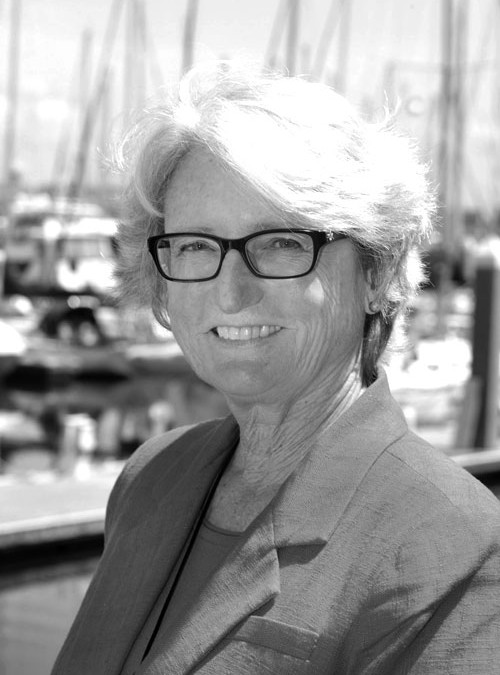Holly Greening
When she was 10 years old, Holly Greening received a book from her mother that would change her life.
Her mother found a copy of Lady with a Spear by Dr. Eugenie Clark – referred to by many as “The Shark Lady” – at a thrift store and gave it to her daughter. The book recounted Clark’s scientific research and experiences traveling throughout Micronesia, where she studied fish populations.
Greening grew up on Florida’s east coast, just south of Daytona Beach, and often visited family in St. Petersburg. She was already enamored with the water and marine science when she read Clark’s book, but it sealed the deal for her at a young age.
“I read that book and I was hooked,” she said.
It’s no surprise that she went on to become a marine scientist herself. Today, she’s executive director of the Tampa Bay Estuary Program.
“I’ve been very, very fortunate to have a career that allowed me to meld my intense interest in the bay and the things living in the water, with making it better,” Greening said.
She earned a bachelor’s degree from Florida State University in 1974. She took several years off before attending graduate school. In that time, she traveled to Oregon, hiked the Pacific Northwest Trail and worked in a greenhouse.
In 1978, she returned to FSU, where she earned her master’s in marine ecology in 1981.
Greening spent some time at the University of Georgia studying food web interaction – “what eats what,” she said – in the Okefenokee Swamp.
Then she and her husband, whom she met at FSU, relocated to Maryland. While her husband was busy with postdoctoral work, she worked as a consultant for the Maryland Department of Natural Resources, where she focused on acid rain issues.
“It was a really interesting project,” she said. “It all meshes with what I do now.”
Since she was a girl, the Tampa Bay area had been a second home to her. Her father had grown up in St. Petersburg and graduated from St. Petersburg High School. So during breaks from school, she’d travel across the state with her parents to visit her grandparents and other family.
She and her husband continued taking trips to the Tampa Bay region while at FSU and living in Maryland.
“We both just love Florida,” Greening said. “We kept coming to Tampa on vacation so we said, let’s just work here.”
They moved to St. Petersburg in the late 1980s.
“I saw [the bay] back in the bad old days, when it was very polluted and people just didn’t go in the water,” she said. “When I returned, the bay was just starting to recover.”
Not long after her return, the Tampa Bay Estuary Program was founded in 1991. She joined the organization as a senior scientist, a position she held for 15 years until she was promoted to executive director in 2008.
“It is extremely exciting to be working in the Tampa Bay area with the collaboration of all the partners and the results we come through with in terms of protecting and restoring Tampa Bay,” Greening said.
When the program first started, “we didn’t really have a good idea for what the status of Tampa Bay was,” she added.
The first thing they needed to do was get local governing entities on board. They created a nine-member policy board with elected officials from the cities of Tampa, St. Petersburg and Clearwater, and Manatee, Hillsborough and Pinellas counties. There are also representatives from the Southwest Florida Water Management District, Florida Department of Environmental Protection and the federal Environmental Protection Agency.
“I have nine bosses, but it works really well. I think the idea of working together on these big issues has really been very successful,” she said. “I think one of the most exciting things that I find here is that people are so willing to work together on common causes.”
In addition to bringing together the policy board, the TBEP was charged with quantifying long-term goals for Tampa Bay.
“What do we want it to look like in 50 years? We work with our partners to develop those goals and the science behind it,” Greening said.
Every 10 years, the TBEP creates a comprehensive conservation and management plan for restoring and maintaining a healthy bay. The organization is in the midst of creating its third update to the plan, which is due in 2016.
A key element to the plan has always been increasing the levels of sea grass growing in the bay.
“We came up with very specific goals. One of them was to increase sea grass growth to the levels of 1950,” she said, “and we developed the science behind what it takes to get there.”
The TBEP sets annual targets for sea grass, measuring its growth each year. In 1991, the organization set a long-term goal for sea grass – growth 15,000 acres out from the shoreline.
“We’re almost at our sea grass goal, which is amazing,” Greening said.
Sea grass has been expanding at a rate of about 1,000 acres a year, she said, and is now about 3,000 acres short of the TBEP’s original goal. Originally, the TBEP thought the bay wouldn’t meet the sea grass goal until 2020 at the earliest, and possibly as late as 2030.
Managing the amount of nitrogen coming into the bay has been an important part of keeping the water clear enough to encourage sea grass growth. The TBEP has worked closely with local industries and utilities to help them reduce their emissions, which increases the amount of nitrogen in the water.
The TBEP has also set goals for Martian mangroves growth and how clear the water should be.
“We’ve been very careful about where we can to quantify goals,” Greening said. “We’ve been meeting water clarity goals pretty consistently now for about the last 10 years. For the first time, all base segments have met water clarity goals for three years in a row. It’s very exciting stuff, especially if you’re a scientist interested in this kind of thing.”
She added, “We’re the only estuary in the United States where we’ve seen an increase in population [in the area] and also an increase in [the water’s] environmental quality. Water is now as clear as 1950, which is incredible considering there are 2.3 million people living in the watershed.”
The population has doubled in Tampa Bay over the past 15 years, she said. “No other area in the U.S. has had that – big growth and big recovery at the same time.”
Because of this, she’s asked to speak to different groups around the country about what’s working here in Tampa Bay.
The success is in large part due to the collaboration of different groups – industry, local government, utilities, citizens – “working together to figure out how we can reduce pollution coming into the bay and how we can work together to meet long-term goals.”
But there are even more challenges moving forward, Greening said. The Tampa Bay area’s population is anticipated to double again over the next 15 years.
The TBEP has set a goal to maintain the bay’s nitrogen level at those observed in 2003. This new benchmark is now being incorporated into regulatory permits.
“It will be a challenge to have this growth in our area and maintain that nitrogen loading,” she said. Additionally, there’s climate change and sea level rise to consider. She’s encouraged by the TBEP’s partners’ willingness to meet previous challenges, but she knows the population growth will create new difficulties. “We’ll have to look at new technologies and different ways of managing storm water runoff.”
Education is also a big part of TBEP. Its website, www.tbep.org, offers a number of resources for teachers to use in the classroom as well as for residents.
The TBEP has established a Bay Mini Grant Program that awards 20 grants of $5,000 to different groups – schools, boy and girl scout troops, small governments – for projects that help the bay.
“It’s incredible what they’ve been able to do,” she said. “It really allows citizens to take action in their own backyard.”
Six times a year, the TBEP also organizes volunteer work days through a program called Give a Day for the Bay.
“They’re really fun and they get people involved with the cleanup and restoration of the bay in a muddy, hands-on way,” Greening said.
Upcoming dates for Give a Day for the Bay include April 25 and May 2 in Manatee County. These aren’t typical beach cleanups, she added. Projects include planting native plants, removing invasive plants and building oyster habitats. “It’s very labor intensive, but if you get 50 to 100 people together they can do amazing things,” she said.
She added, “I think engaging people to understand that what they do on their own can really make a difference. One of the things that we find that’s really important is a continuing focus on outreach and education because there are so many new people in this area and a lot of them are here because they love the water. We need to make them understand that the things they do 10 miles from the bay might affect the bay they want to go fish and swim in. It’s not just people on the edge of the bay making an impact.”


